In today's data-driven markets, understanding the 'why' behind customer actions and market movements is more critical than ever. Surface-level metrics like likes and shares only tell part of the story. To truly gain a competitive edge, you need to dive deeper into the emotions and opinions hidden within text data from reviews, social media, and financial news.
This is where sentiment analysis comes in, transforming unstructured feedback into actionable insights. However, the market for these platforms is crowded and complex. Choosing the right one depends entirely on your specific needs, whether you are a retail trader gauging market mood with a tool like the Fear & Greed Tracker, a developer needing a powerful API from AWS or Google Cloud, or a marketer tracking brand health.
This guide cuts through the noise to help you find the best sentiment analysis tools for your goals. We will navigate the top 12 options, providing a detailed breakdown of each platform's features, ideal use cases, pricing, and honest pros and cons. Each review includes screenshots and direct links, so you can quickly evaluate and select the perfect solution to start decoding what your audience and the market really think.
1. Fear Greed Tracker
Fear Greed Tracker stands out as a premier choice among the best sentiment analysis tools, specifically engineered for the financial markets. It empowers traders and investors by translating the complex, often chaotic, world of market emotion into clear, actionable data. The platform's core strength lies in its proprietary 16-indicator algorithm, which generates real-time Fear & Greed scores for an extensive universe of over 50,000 stocks and cryptocurrencies. This allows users to move beyond gut feelings and base their strategies on a quantified measure of market sentiment.
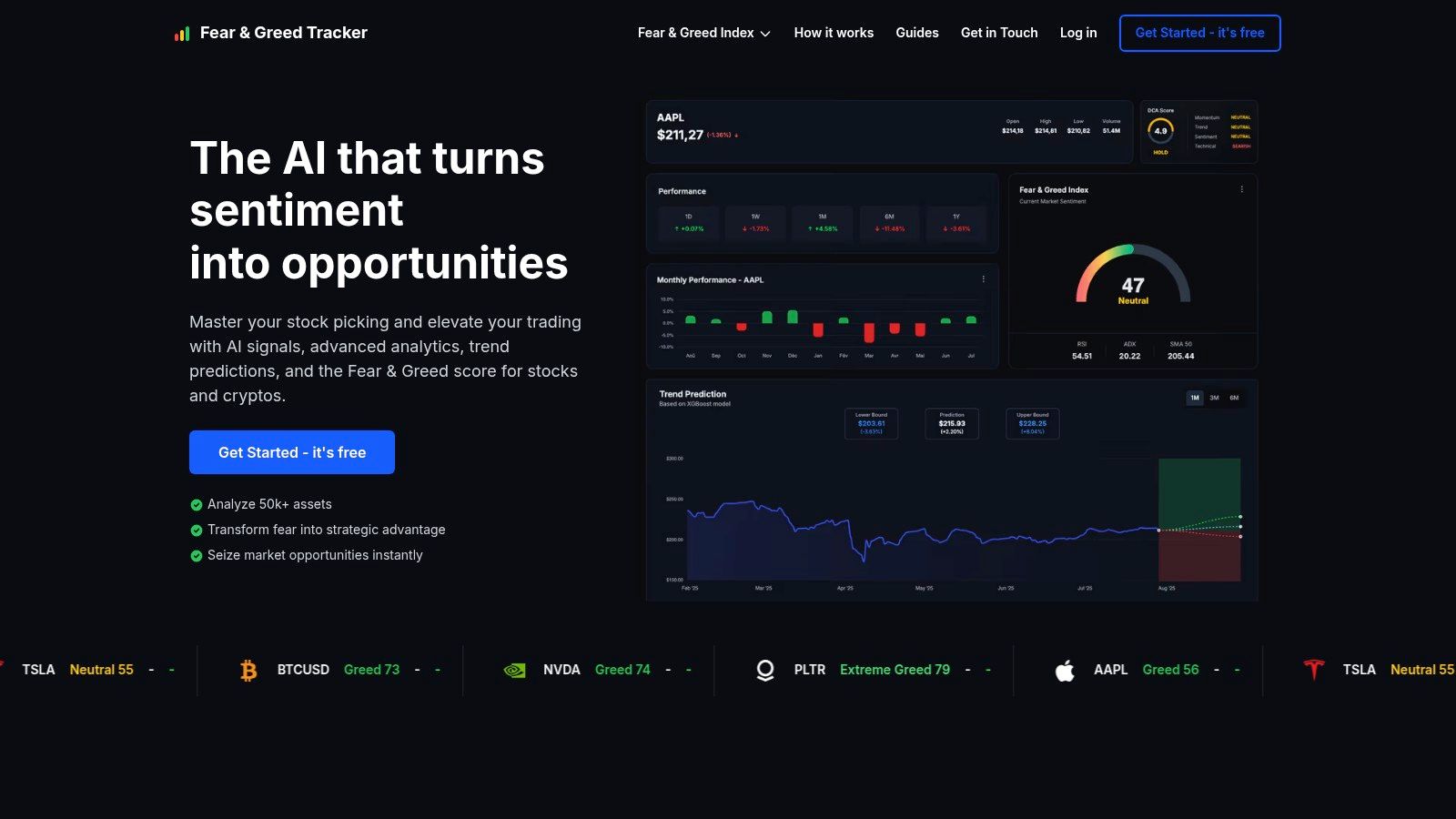
Unlike generic tools, Fear Greed Tracker integrates this sentiment analysis with fundamental data, technical indicators, and social media buzz, providing a truly holistic view. This synthesis is crucial for identifying market tops driven by extreme greed or pinpointing buying opportunities born from extreme fear. For those seeking even more direct guidance, its AI-powered daily signals offer a compelling advantage.
Key Features & Use Cases
- Real-Time Sentiment Scores: Access live Fear & Greed scores across 50,000+ assets. This is ideal for day traders needing to gauge intraday sentiment shifts or for long-term investors looking to identify optimal entry points during periods of market panic.
- AI-Driven Trading Signals: The platform offers AI-generated buy, sell, and hold signals, which boast a reported 81.65% win rate. Swing traders can leverage these alerts to confirm their own analysis and improve timing precision.
- Comprehensive Data Integration: It combines technicals, fundamentals, and social sentiment. A portfolio manager could use this to validate a stock's strong fundamentals against prevailing market sentiment before committing capital.
- Customizable Alerts: Set notifications for specific assets when they cross certain Fear & Greed thresholds. This proactive feature ensures you never miss a critical sentiment shift in your watchlist.
Pricing
Fear Greed Tracker operates on a freemium model. Users can get started with a free account, which provides access to core features. For advanced capabilities, AI signals, and more in-depth data, you will need to inquire about their premium pricing tiers.
Pros & Cons
| Pros | Cons |
|---|---|
| Extensive Coverage: Real-time sentiment for 50,000+ stocks & crypto. | Not Financial Advice: Insights are for informational purposes only. |
| High-Success AI Signals: AI-backed daily signals with a proven 81.65% win rate. | Pricing Inquiry: Advanced feature costs are not explicitly listed on the website. |
| Holistic Analysis: Integrates sentiment, technical, and fundamental data. | |
| User-Friendly: Intuitive interface paired with excellent educational content. |
For a deeper dive into the methodologies, you can explore their detailed guide to stock market sentiment analysis.
Website: https://feargreedtracker.com
2. Amazon Web Services – Amazon Comprehend
For developers and data teams already integrated into the AWS ecosystem, Amazon Comprehend stands out as one of the best sentiment analysis tools due to its seamless integration and scalability. It's a fully managed Natural Language Processing (NLP) service that goes beyond basic sentiment to offer targeted sentiment analysis, which pinpoints the sentiment towards specific entities within text. This is incredibly useful for financial analysts wanting to know not just if a news report is positive, but if it's positive specifically about a certain company's earnings.

Its power lies in its serverless architecture, allowing you to analyze massive volumes of data from sources like Amazon S3 or Kinesis without managing any infrastructure. This makes it ideal for processing real-time social media streams or vast archives of financial reports.
Key Features & Considerations
- Pricing: AWS offers a generous free tier for the first 12 months, including 50,000 units (5 million characters) for the sentiment analysis API each month. After that, it uses a pay-as-you-go model. Be mindful that pricing is per 100 characters, with a 300-character minimum charge per request.
- Use Cases: Perfect for building custom applications that need to analyze customer feedback from support tickets, social media mentions, or product reviews at scale.
- Pros: The integration with other AWS services is a significant advantage, creating a powerful, automated data processing pipeline.
- Cons: While powerful, the cost structure for custom models can become complex, adding expenses for model training and maintaining active endpoints.
Website: https://aws.amazon.com/comprehend/
3. Google Cloud – Natural Language AI
For organizations invested in the Google Cloud Platform, the Natural Language AI is one of the best sentiment analysis tools available, offering a powerful and scalable solution. It provides highly accurate document-level sentiment, which gives a score for an entire text block, and entity sentiment analysis. This latter feature is particularly valuable for financial analysts who need to understand market perception not just of a company, but of its specific products or executives mentioned in news articles.

Its direct accessibility via API makes it easy to integrate into existing applications or data pipelines, allowing for real-time analysis of customer reviews or social media feeds. The service is known for its excellent documentation and client libraries, which simplify implementation for development teams.
Key Features & Considerations
- Pricing: Google offers a free tier that includes the first 5,000 units (5,000 characters) per month for sentiment analysis. After the free tier, pricing is competitive and billed per 1,000 characters. Be aware that multi-feature requests can affect the character-unit accounting.
- Use Cases: Ideal for analyzing large datasets of text, such as product reviews, survey responses, or news feeds to gauge public opinion and track brand perception.
- Pros: The per-feature pricing model can be cost-effective if you only need specific capabilities. Strong documentation and a generous free tier make it highly accessible.
- Cons: Character-unit billing for multi-feature calls can be confusing to calculate initially. Complex NLP tasks might require integrating other services from the Google AI suite.
Website: https://cloud.google.com/natural-language
4. Microsoft Azure – AI Language (Text Analytics)
For organizations heavily invested in the Microsoft ecosystem, Azure's AI Language service (formerly Text Analytics) is one of the best sentiment analysis tools available. Its key differentiator is a feature called "opinion mining," which drills down to the aspect level, identifying sentiment associated with specific attributes of a product or service. This allows a company to see not just that a review is negative, but that the negativity is specifically directed at battery life, for instance.
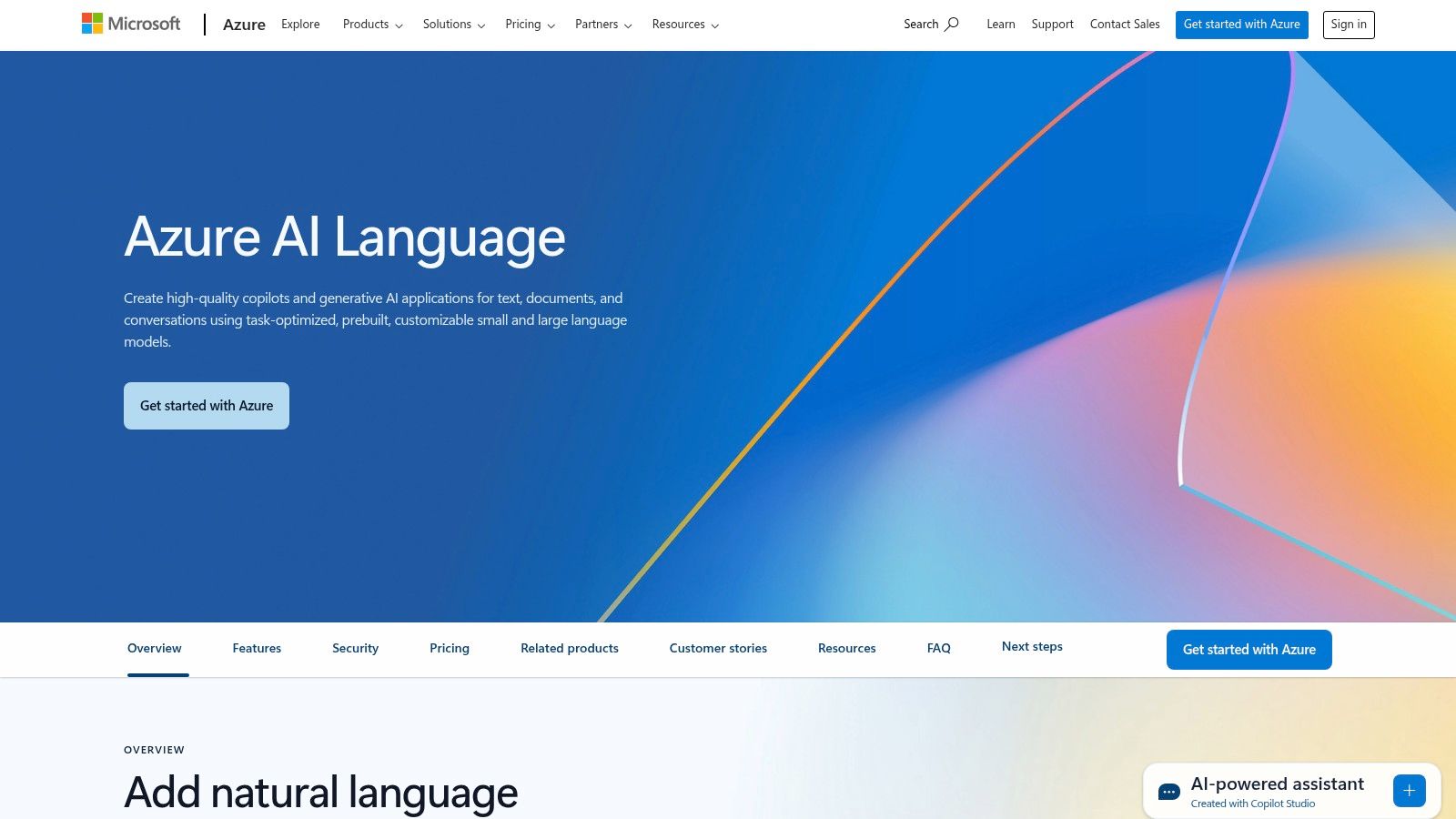
The service provides notable deployment flexibility, offering container support that allows businesses to run the sentiment analysis models on-premises or at the edge. This is critical for organizations with strict data governance or low-latency requirements, such as analyzing financial communications in real-time without sending data to the cloud.
Key Features & Considerations
- Pricing: Azure provides a free tier with 5,000 text records per month. Beyond that, it follows a pay-as-you-go model based on the volume of "text records," which are blocks of 1,000 characters.
- Use Cases: Ideal for detailed product feedback analysis, brand monitoring, and employee experience assessment where understanding sentiment towards specific features is crucial.
- Pros: The generous free tier is a great starting point, and its enterprise-grade governance and broad regional availability are major advantages for large corporations.
- Cons: Pricing tables can be complex, with some advanced features priced separately. The deprecation of older pricing tiers can also add a layer of confusion for new users.
Website: https://azure.microsoft.com/en-us/products/ai-services/ai-language
5. IBM – Watson Natural Language Understanding (NLU)
For enterprises looking for robust, production-ready NLP, IBM's Watson Natural Language Understanding (NLU) is one of the best sentiment analysis tools available. It distinguishes itself with sophisticated emotion analysis, which goes beyond positive or negative to detect joy, sadness, anger, fear, and disgust. This is invaluable for marketing teams aiming to understand the nuanced emotional response to a new product launch or advertising campaign, providing a deeper layer of insight than standard sentiment scores.
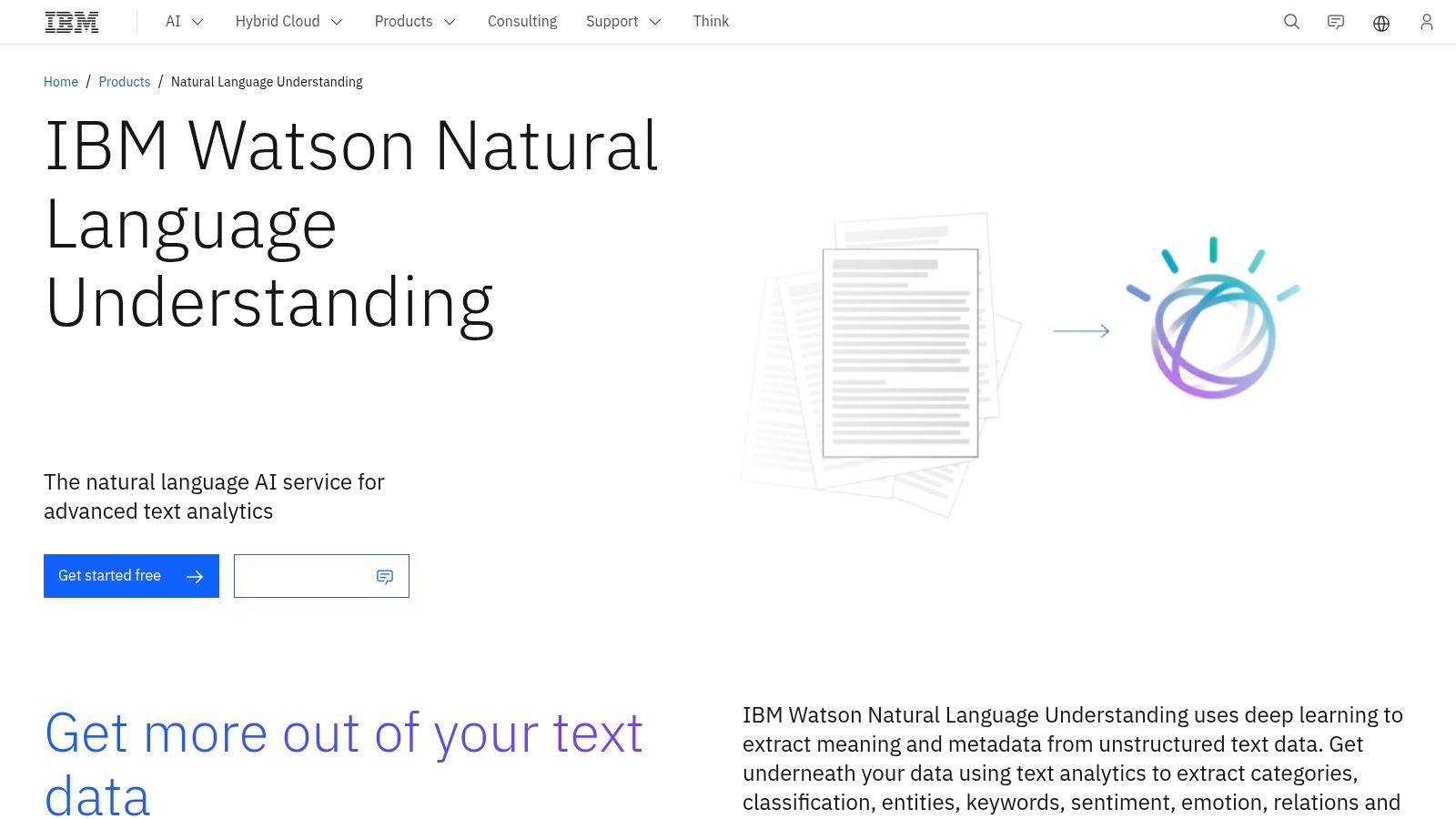
As part of the broader IBM Cloud and watsonx ecosystem, it offers strong integration and scalability for complex enterprise needs. Its ability to analyze text in multiple languages and support custom model creation makes it highly adaptable for businesses operating globally or within specialized industries like finance or healthcare.
Key Features & Considerations
- Pricing: IBM offers a perpetual Lite plan that includes 30,000 NLU items per month for free, which is excellent for development and testing. Paid plans follow a tiered, per-item pricing model that becomes more cost-effective with higher volume, but requires careful planning to estimate costs.
- Use Cases: Ideal for detailed customer voice analysis, brand monitoring, and content categorization. The emotion analysis feature is particularly useful for gauging public reaction to market news or corporate announcements.
- Pros: The transparent pricing with built-in cost calculators and a generous free tier makes it accessible for initial testing. Its enterprise-grade support and extensive documentation are significant advantages.
- Cons: Building and deploying custom models for entities or classifiers incurs additional fees, and the per-item pricing structure requires careful management to avoid unexpected costs at scale.
Website: https://www.ibm.com/products/natural-language-understanding
6. MonkeyLearn
MonkeyLearn empowers non-technical users to build and deploy custom text analysis models, making it one of the best sentiment analysis tools for teams without dedicated data scientists. Its no-code/low-code interface simplifies the process of creating tailored classifiers for specific business needs, such as sorting customer support tickets by urgency or analyzing product reviews for key themes. This focus on accessibility allows marketing and customer service teams to directly harness the power of NLP.

The platform's strength lies in its end-to-end workflow, from building a model using pre-built templates to visualizing the results in interactive dashboards. Integrations with tools like Google Sheets, Zapier, and Zendesk mean you can automate feedback analysis directly within your existing software stack, creating powerful, automated loops for understanding customer sentiment. While it may not be geared towards financial market data out-of-the-box, its customizable nature could be adapted for specific news or social media analysis.
Key Features & Considerations
- Pricing: MonkeyLearn offers a free plan for exploration and small projects. Paid plans are based on the number of queries and can become more expensive than API-only competitors, especially for high-volume use cases which often require engaging with their sales team for a custom quote.
- Use Cases: Ideal for customer feedback analysis, support ticket routing, and survey response categorization. It excels where business users need to quickly prototype and deploy custom models. To learn more about how to apply these concepts, you can explore guides on how to use market sentiment analysis for trading.
- Pros: The intuitive, no-code model builder and seamless integrations make it incredibly fast for non-technical teams to get started and see value.
- Cons: The pricing structure can be a significant step up from developer-focused APIs, and scaling to very large volumes typically requires a more expensive enterprise plan.
Website: https://monkeylearn.com/
7. Lexalytics (Semantria/Salience) by InMoment
For organizations in regulated or data-sensitive fields, Lexalytics offers one of the best sentiment analysis tools by providing unparalleled deployment flexibility and enterprise-grade features. Now part of InMoment, its platform is available as a SaaS API (Semantria) or an on-premises engine (Salience), giving full control over data privacy and security. This makes it a top choice for healthcare, finance, or government entities that cannot send sensitive data to third-party clouds.
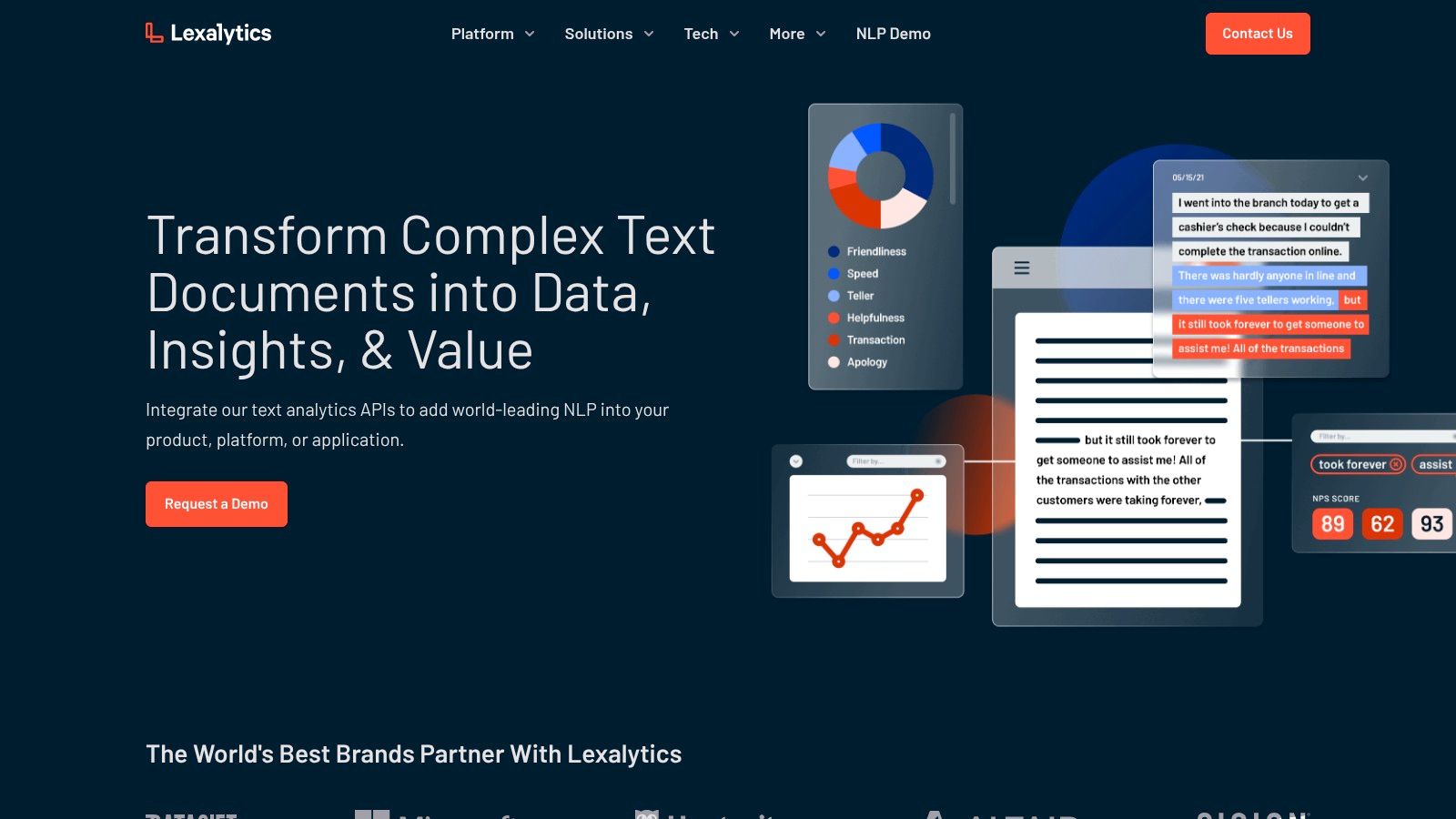
Its core differentiator is the use of Industry Packs, which are pre-tuned models optimized for the specific language and context of sectors like hospitality, pharmaceuticals, and retail. This significantly improves accuracy out-of-the-box by understanding domain-specific jargon and sentiment drivers, such as analyzing sentiment in adverse event reports for a pharma company.
Key Features & Considerations
- Pricing: Enterprise-focused with custom, sales-quoted pricing. This model is typically premium and may not be suitable for small teams or startups looking for a simple pay-as-you-go API.
- Use Cases: Ideal for large-scale voice of the customer (VoC) programs, market intelligence in regulated industries, and complex text analytics where data must remain on-premises.
- Pros: The option for on-premises deployment is a major advantage for data security. The platform's maturity and industry-specific tuning provide highly accurate, contextual analysis.
- Cons: The setup and customization require more technical effort compared to simpler, plug-and-play APIs. The enterprise pricing structure can be a barrier for smaller organizations.
Website: https://www.lexalytics.com/
8. MeaningCloud
MeaningCloud offers a flexible and developer-friendly SaaS API that excels in multilingual sentiment analysis. It stands out with its optional vertical packs, which provide pre-trained models for specific domains like Voice of the Customer (VoC) and finance. This makes it a strong contender among the best sentiment analysis tools for businesses that need specialized analysis without building custom models from scratch. For instance, a global e-commerce brand can use the VoC pack to instantly analyze product reviews in multiple languages.
The platform's API is highly configurable, allowing users to define their own dictionaries and sentiment models to improve accuracy for niche topics. This level of customization, combined with broad language support and integrations with tools like Excel and RapidMiner, makes it a powerful and accessible choice for detailed text analytics projects.
Key Features & Considerations
- Pricing: Operates on a credit-based, pay-as-you-go model with a generous free plan that includes 20,000 credits per month. Credits are consumed based on text length and the specific APIs used, requiring users to monitor their consumption carefully.
- Use Cases: Ideal for analyzing customer feedback, employee surveys, and social media conversations, especially for international companies needing robust multilingual support.
- Pros: The low-cost entry point and specialized vertical packs provide a fast track to implementing domain-specific sentiment analysis.
- Cons: Achieving the highest accuracy often requires investing time in customization and building custom dictionaries. The credit-based billing can be complex to predict for varied text lengths.
Website: https://www.meaningcloud.com/
9. Brandwatch – Consumer Research
For enterprise-level brand management and market research, Brandwatch offers one of the most comprehensive social listening platforms available. It excels at delivering automated sentiment and emotion analysis in real-time across a vast ocean of social media and web sources. This makes it an invaluable tool for brand managers needing to instantly track public perception during a product launch or a PR crisis, allowing for rapid response and strategy adjustment.
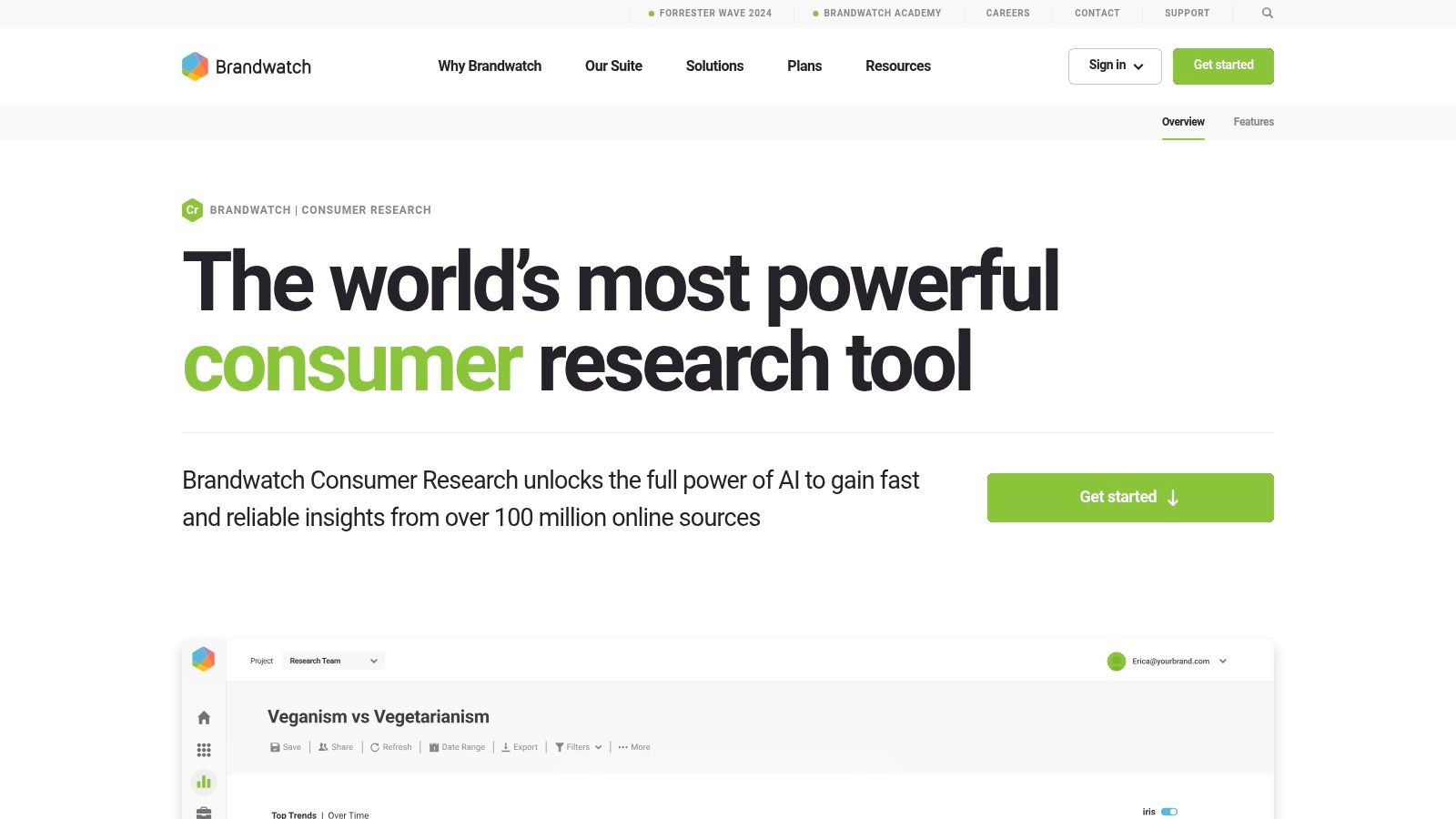
Its strength is not just in identifying positive or negative sentiment but in detecting specific emotions like joy, anger, and fear. This granular insight, combined with powerful filtering and alerting, helps teams move beyond simple metrics to understand the why behind consumer feelings. The platform is truly one of the best sentiment analysis tools for organizations that need deep, actionable consumer intelligence.
Key Features & Considerations
- Pricing: Enterprise-level pricing is available upon request and is tailored to data volume and feature needs. This is not a tool for individual users or small businesses.
- Use Cases: Ideal for large marketing, PR, and consumer research teams monitoring brand health, tracking campaign performance, and identifying emerging market trends.
- Pros: The sheer breadth of social data coverage is a major advantage, supported by robust, real-time alerting and deep dashboard customization for strategic reporting.
- Cons: The platform's sentiment accuracy on broad, unstructured social data typically ranges from 60–75%, which may require manual verification for high-stakes analysis.
Website: https://www.brandwatch.com/products/consumer-research/
10. Sprout Social
For social media managers who need sentiment analysis embedded directly into their daily workflow, Sprout Social is one of the best sentiment analysis tools available. Unlike standalone analytics platforms, it integrates sentiment scoring directly into the Smart Inbox, allowing teams to instantly gauge the tone of incoming messages and reviews. This operational approach helps prioritize responses and quickly flag potential brand crises.

While basic sentiment is built-in, the platform’s real power for market analysis comes from its optional Listening add-on. This feature allows for deeper tracking of sentiment trends around specific topics, keywords, or campaigns, transforming social chatter into actionable business intelligence. Learn more about the nuances of social sentiment to better understand how these insights can be leveraged.
Key Features & Considerations
- Pricing: Plans are premium-priced and charged per user, starting with the Standard plan. Advanced features like the Listening add-on for in-depth sentiment analysis require higher-tier plans or are available as a separate purchase.
- Use Cases: Ideal for marketing teams and customer care departments managing brand reputation, identifying customer pain points, and measuring campaign reception directly on social media.
- Pros: The intuitive UI and integration with publishing and reporting tools make it easy to operationalize sentiment data within a single platform.
- Cons: The per-seat pricing can be costly for larger teams, and the most powerful sentiment analysis capabilities are locked behind an expensive Listening add-on. It's also focused exclusively on social data.
Website: https://sproutsocial.com/
11. RapidAPI Hub – Sentiment Analysis APIs Marketplace
For developers and teams who value flexibility and comparison, the RapidAPI Hub is an essential resource. Instead of being a single tool, it’s a massive marketplace where you can discover, test, and integrate numerous third-party sentiment analysis APIs from providers like Twinword and MeaningCloud. This unique position makes it one of the best sentiment analysis tools for prototyping, as you can quickly swap between different engines to see which performs best on your specific dataset without committing to a single vendor.

The platform streamlines the development process by offering a single API key and centralized billing for multiple services. This is ideal for projects that might need a niche API for a specific language or industry, allowing you to find specialized solutions that larger, monolithic platforms may not offer.
Key Features & Considerations
- Pricing: Varies significantly by API provider. Most offer a freemium model with a limited number of free daily or monthly requests, followed by tiered subscription plans. Users must check each API's pricing page on the hub.
- Use Cases: Excellent for developers building applications who want to compare different sentiment analysis models or find niche APIs for specific languages or financial document analysis.
- Pros: The ability to rapidly test and compare multiple APIs from a single dashboard is a major advantage for finding the perfect fit.
- Cons: Quality, documentation, and reliability can vary widely between the different API providers on the marketplace. You are dependent on the third-party developer for support and uptime.
Website: https://rapidapi.com/
12. G2 – Software Category/Feature Pages Covering Sentiment
While not a tool itself, G2 is an indispensable resource for vetting and shortlisting the best sentiment analysis tools on the market. It serves as a comprehensive buyer-oriented platform, aggregating user reviews, satisfaction ratings, and detailed feature comparisons for dozens of social listening and text analytics suites. This makes it an essential first stop before committing to a paid subscription or complex API integration.
Its real value lies in providing an unfiltered look at a tool's performance through the lens of actual users. The platform uses AI to summarize pros and cons from hundreds of reviews, giving you a quick, balanced understanding of a product's strengths and weaknesses that you won't find in marketing materials.
Key Features & Considerations
- Pricing: G2 is completely free for buyers to use for research and comparison. Pricing information for the tools listed is provided by the vendors and may not always be public.
- Use Cases: Ideal for market researchers, marketing managers, and product teams during the software discovery and procurement phase. It helps narrow down options based on specific needs like budget, company size, and required features.
- Pros: Authentic user feedback provides a crucial reality check against vendor claims, and the platform is excellent for discovering adjacent or alternative software solutions.
- Cons: As a review aggregator, it relies on vendor-supplied information which can be incomplete. Its broad category definitions might also overlook highly specialized or niche developer APIs.
Website: https://www.g2.com/
Top 12 Sentiment Analysis Tools Comparison
| Platform | Core Features/Characteristics | User Experience & Quality Metrics | Value Proposition & Pricing | Target Audience | Unique Selling Points & Highlights |
|---|---|---|---|---|---|
| 🏆 Fear Greed Tracker | Real-time sentiment scores on 50,000+ assets, 16-indicator AI | ★★★★★ 81.65% AI signal win rate | 💰 Free to start, premium tiers possible | 👥 Retail investors, day traders, advisors | ✨ AI-driven signals, customizable alerts, educational guides |
| Amazon Web Services – Amazon Comprehend | Prebuilt sentiment APIs, serverless, AWS ecosystem integration | ★★★★ Generous free tier (50K units/mo) | 💰 Per-character pricing, scalable | 👥 Developers, data teams | ✨ HIPAA-eligible, AWS native integrations |
| Google Cloud – Natural Language AI | Document & entity-level sentiment, multi-feature API calls | ★★★★ Free 5K units/mo, strong docs | 💰 Competitive pay-as-you-go pricing | 👥 App developers, data engineers | ✨ Clear character billing, extensive analysis options |
| Microsoft Azure – AI Language (Text Analytics) | Sentiment with opinion mining, PII detection, container support | ★★★★ 5K free records/mo, enterprise-grade governance | 💰 Standard pricing per 1,000 chars | 👥 Enterprises, on-prem users | ✨ On-prem/container deployment, aspect-level sentiment |
| IBM – Watson NLU | Sentiment, emotion, multilingual, custom model options | ★★★★ Perpetual Lite plan 30K items/mo | 💰 Tiered per-item pricing | 👥 Enterprises needing NLP solutions | ✨ Emotion analysis, strong documentation |
| MonkeyLearn | No-code model builder, dashboards, APIs | ★★★★ Fast prototyping for non-technical | 💰 Higher entry pricing | 👥 Customer support, feedback teams | ✨ Drag-drop builder, workflow integrations |
| Lexalytics (Semantria/Salience) by InMoment | Enterprise sentiment & thematic analytics, on-prem & SaaS | ★★★★ Mature enterprise features | 💰 Premium, sales-quoted pricing | 👥 Regulated industries | ✨ Industry Packs, rule-tuning, multi-language |
| MeaningCloud | Credit-based sentiment API, 50+ languages, vertical packs | ★★★ Low-cost entry, vertical specialization | 💰 Credit billing with usage monitoring | 👥 Industry-specific analysts | ✨ Voice of customer/employee focus, multi-lang |
| Brandwatch – Consumer Research | Real-time social sentiment & emotion, 40+ languages | ★★★★ Extensive social data coverage | 💰 Enterprise-level, request pricing | 👥 Brand/research teams | ✨ Emotion alerts, advanced dashboards |
| Sprout Social | Social media mgmt with built-in sentiment & optional Listening | ★★★★ Intuitive UI, US support | 💰 Per-seat premium pricing | 👥 Social media teams | ✨ Easy sentiment integration in workflows |
| RapidAPI Hub – Sentiment Analysis Marketplace | Aggregated sentiment APIs, single key, various vendors | ★★★ Scannable API offerings | 💰 Free/low-cost tiers available | 👥 Developers & testers | ✨ Multiple APIs, centralized billing |
| G2 – Software Category/Feature Pages | Reviews, ratings, comparisons of sentiment tools | ★★★★ Real user feedback for informed buying | 💰 Free to use, vendor pricing linked | 👥 Buyers shortlisting tools | ✨ User-generated pros/cons summaries |
Choosing the Right Tool to Turn Sentiment into Strategy
Navigating the landscape of sentiment analysis platforms can feel overwhelming, but as we've detailed, the key is aligning the tool's core strengths with your specific objectives. The journey from raw data to actionable insight is unique for every user, whether you are a day trader, a product manager, or a developer building the next big application. The term "best sentiment analysis tools" is subjective; the optimal choice for one user may be entirely unsuitable for another.
The platforms we've explored range from highly specialized financial indicators to comprehensive, enterprise-grade AI ecosystems. Your decision-making process should be a deliberate evaluation of trade-offs. It's a balance between power and usability, customization and out-of-the-box functionality, and cost versus potential return on investment.
A Framework for Your Final Decision
To help you move forward, consider this simplified framework for selecting your ideal tool. Ask yourself these critical questions:
- Who is the end-user? Are you a non-technical marketer who needs a user-friendly dashboard like Sprout Social, or a developer who requires the robust API and model-building capabilities of Google Cloud Natural Language AI or Amazon Comprehend?
- What is your primary data source? If you're analyzing financial market chatter from news and social media, a purpose-built tool like the Fear Greed Tracker is invaluable. For analyzing internal customer feedback from surveys and support tickets, platforms like MonkeyLearn or MeaningCloud offer powerful, customizable models.
- What is your required level of granularity? Do you need a simple positive/negative/neutral score, or do you require more nuanced analysis like aspect-based sentiment, emotion detection, or intention analysis? The major cloud providers (AWS, Azure, IBM) and specialists like Lexalytics excel at delivering these deeper insights.
- How important is real-time processing? For traders and brand reputation managers, latency is critical. Platforms like Brandwatch and APIs available through RapidAPI Hub are designed for high-velocity data streams, providing the speed necessary to react to market or public opinion shifts instantly.
Implementation and Beyond
Once you've made your choice, the work has just begun. Successful implementation requires more than just plugging in an API key. It demands a clear strategy for what you will measure, how you will interpret the results, and what actions you will take based on the sentiment data. Remember that all AI models have limitations and biases. Always start with a pilot project to test the tool's accuracy against your specific data and use cases before deploying it at scale. Continuously monitor its performance and be prepared to refine your models or workflows as needed.
Ultimately, these tools are not magic wands; they are powerful amplifiers. They give you the ability to listen to the market, your customers, or your audience at an unprecedented scale. By choosing wisely and implementing strategically, you can transform the cacophony of public opinion and customer feedback into a clear, data-driven strategy that powers growth and mitigates risk.
Ready to see how real-time market sentiment can directly impact your trading decisions? For investors and traders who need to cut through the noise, Fear Greed Tracker specializes in distilling complex market emotions into a single, actionable indicator. Visit the Fear Greed Tracker to see how our focused approach to financial sentiment analysis provides a critical edge in today's volatile markets.
